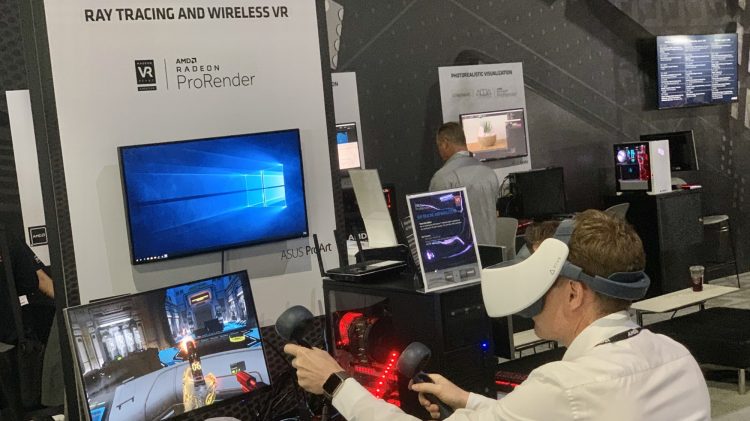Virtual reality headsets have come a long way over the past five years, and in the next five years, they’ll take even bigger steps forward thanks to advances in computer graphics and display technologies. But as I saw at this year’s Siggraph conference in Los Angeles, next-generation wireless technologies are the missing link for the next evolution of VR, as current-generation wireless VR hardware falls short of the fluid immersion users would expect.
Lots of Siggraph exhibitors were showing off new offerings using third-party VR headsets, including major players such as Intel and numerous smaller companies and artists. Almost invariably, the headsets were tethered with cables — not for show floor security, but specifically to take advantage of a nearby computer’s horsepower. And the reason was obvious: Companies focused on cutting-edge computer graphics tend to want all the bandwidth and responsiveness a wired connection can deliver.
One notable exception was AMD, which caught my attention with a demo labelled “Ray Tracing and Wireless VR.” I walked over to the demo and saw a man clearly enjoying a dual-handed first-person shooter (Raw Data) that was being streamed from a full tower PC. An AMD rep noted that the PC was equipped with not just one but two new Radeon graphics cards, plus a dedicated wireless router so it could have uninterrupted streaming connectivity to the headset, HTC’s Vive Focus Plus.
It’s worth underscoring that the headset and router were both using current-generation Wi-Fi — 802.11ac, also known as Wi-Fi 5 — rather than the incoming sequel, 802.11ax (aka Wi-Fi 6), or its more obscure cousin 802.11ay. PC tinkerers have been using 802.11ac connections at home to stream games to headsets such as Oculus Quest, but Oculus shut down one of the streaming apps, suggesting that wireless streaming on the platform would deliver a laggy, sub-par experience. Instead, HTC and others have been selling wireless adapters based on 802.11ay’s similarly obscure predecessor WiGig, which uses a millimeter wave connection to deliver a high-bandwidth, lower-latency alternative.
When I put on the AMD-provided headset to test a game I know well, Space Pirate Trainer, I could notice the lag between my motions and what was happening in the headset, a key issue that prevented me from regularly hitting even the title’s earliest moving targets. And this was with nearly ideal testing hardware. It’s one thing to think you’re experiencing sub-par wireless VR performance on a home computer with a shared Internet connection, a single graphics card, and whatever wireless headset you might be able to afford. Doing a test on a fully equipped AMD rig with a dedicated router, dual video cards, and a modern $600 headset effectively confirms that while Wi-Fi 5 delivers plenty of bandwidth, it’s the choking point for an otherwise fluid VR experience.
On the cellular side, one of 5G’s key selling points is a dramatic reduction in latency, such that connections between serving and receiving devices will — under the right conditions — be virtually instantaneous. Even if the computer doing the rendering isn’t in your home, a nearly compute-free VR headset should benefit from the levels of pixel-level detail and responsiveness that are presently only achievable on a physically tethered connection. A headset combining a 5G stream with its own computing abilities could be even better.
Wi-Fi looks like it will be more complicated. The Wi-Fi 6/802.11ax standard effectively evolves the Wi-Fi 5/802.11ac experience users have known for years, using the same wireless spectrum (2.4GHz and 5GHz) to deliver greater bandwidth to even more devices at the same time. That’s great to deliver all of the graphic detail realistic VR needs, but whether the lag will be meaningfully reduced is up in the air. There have been reports that Wi-Fi 6 may cut latency by 75% compared with Wi-Fi 5, but 802.11 engineers are still working on a standard that could match or beat 5G’s millisecond-level responsiveness. It remains to be seen whether soon-to-be-common Wi-Fi 6 routers or specialized ones based on its millimeter wave-based cousin 802.11ay will become the basis for most non-cellular wireless VR headsets.
Today, most of the discussion of truly wireless, high-fidelity VR streaming is theoretical. Users can already stream 360-degree and stereoscopic content from nearby computers or over the internet, but like the early days of 2D video, it’s obviously pixelated if not hugely artifacted, as well as laggy, and limited in immersiveness, even when piped through the servers of a long-term streaming expert such as YouTube. But at Siggraph, it was obvious that both content creators and computer graphics hardware developers have much greater ambitions for virtual reality than what today’s headsets can offer. They’re just waiting for the wireless tech to catch up to start delivering it.

